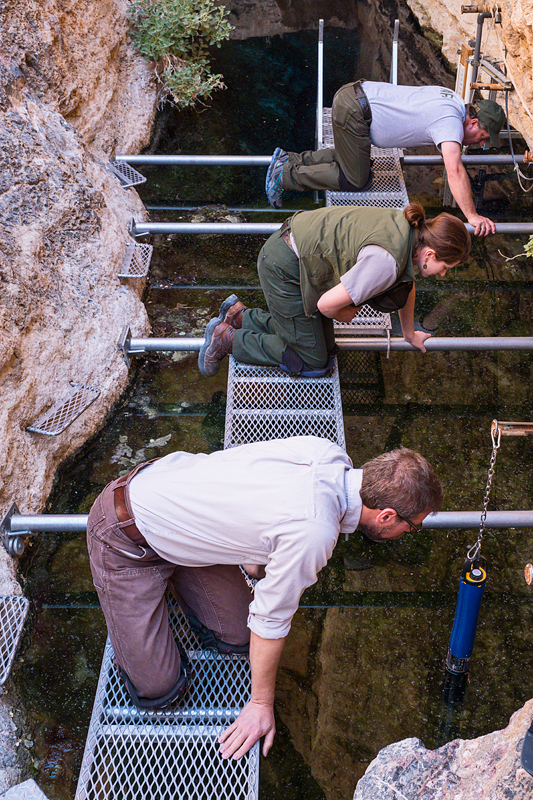News Release
You are viewing ARCHIVED content published online before January 20, 2025.
Please note that this content is NOT UPDATED, and links may not work. For current information,
visit https://www.nps.gov/aboutus/news/index.htm.

NPS photo
|
Subscribe
|
Contact: Kevin Wilson, 775-537-0787 x207
Contact: Michael Schwemm, 702-515-5079
Contact: Brandon Senger, 702-486-5127 x3300
AMARGOSA VALLEY, NV –Wildlife biologists have good news to report about one of the world’s rarest fishes. Scientists counted 187 Devils Hole pupfish, which is the most they’ve observed in fifteen years.“We are not out of the woods, but this is a good step in the continued recovery efforts for this fish,” stated Kevin Wilson, Aquatic Ecologist for Death Valley National Park.
For decades, scientists counted about 200 Devils Hole pupfish in the spring and about 450 in the fall. Pupfish numbers have been precariously low in recent years, dropping to 38 pupfish in 2006-2007 and 35 pupfish in 2013.
The only natural habitat of Devils Hole pupfish (Cyprinodon diabolis) is the upper 80 feet of a deep water-filled cavern and sun-lit shallow pool at the cavern’s entrance. Devils Hole is located in a detached unit of Death Valley National Park adjacent to Ash Meadows National Wildlife Refuge in Nye County, Nevada.
US Fish and Wildlife Service, Nevada Department of Wildlife, and National Park Service staff and volunteers worked together on the official fish count, following methods used since 1972. Some scientists donned scuba gear to count fish in the cavern, starting at 100 feet below the surface. Meanwhile other scientists stayed on the surface to count fish in the shallow pool. The surface and underwater numbers were added together. Researchers conducted multiple counts on September 29 and 30.
The official result, 187 observable pupfish, is the highest count recorded since September 2003. Michael Schwemm, Senior Fish Biologist for the US Fish and Wildlife Service, said, “In natural systems it’s important to appreciate that small populations fluctuate in size seasonally and annually, and it is not uncommon to gain or lose 30 fish between counts. Still, our current count far exceeds this margin.”
The scientists were also pleased by how healthy the pupfish looked, and their age range. “The majority of the fish we counted were juveniles and young adults,” stated Brandon Senger, Supervising Fisheries Biologist for Nevada Department of Wildlife. “This population structure is what is really important and we will continue to monitor this closely.”
Corey Lee, Ash Meadows National Wildlife Refuge Manager, described the interagency team as “cautiously optimistic.” Trends can change quickly. The next pupfish count will be held in the spring.
-www.nps.gov/deva-
Last updated: September 22, 2022
